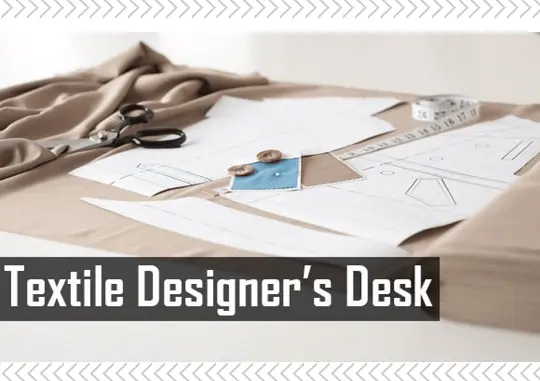What Tools and Equipment on The Textile Designers Desk?
If you work in the textiles industry, whether you work for a company or are self-employed, tidy probably isn’t a word that you would associate with your working space. Perhaps the phrase ‘organized chaos’ would be more apt because, although you may not remember what the surface of your desk looks like, everything is where you want/need it to be. In this article, we present What Tools and Equipment on The Textile Designers Desk?
In any industry, being a designer means your working space is at least 50% rough designs screwed up and started again because you’re not quite happy with it. In Textiles, it means having piles of fabric, cutting equipment, and drawings surrounding a computer. Explore a comprehensive range of tools and equipment for the textile designer’s desk below.

List of Tools and Equipment of Textile Designers Desk
The following tools and equipment should be kept on the Textile Designers Desk:
1. Computer
We will start with the obvious, the computer. Especially for the self-employed, this is the most important part of your desk. Depending on your age, this could be where the majority of your designs are mapped out. Of course, you could be old-school and opt for a pen and paper to draw out your ideas before transferring to the computer, but in the modern day, you will undoubtedly have some kind of computer (and emails) greeting you in the morning.
2. Rough Sketches
Lots and lots of rough sketches as far as the eye can see. A true designer is never satisfied with their work because there is always room for improvement. However, deadlines and demands mean that we settle for what we consider to be our best ‘final’ draft. Any designer will understand what we mean by that.
Often, there will be books of rough sketches that have been left for days or weeks (even months) so that we can go back to them with a fresh eye. How many times have you looked over a piece of work that you stressed over for hours, only to make the simplest of changes that make all the difference? Countless, which is why you should never completely disregard old sketches. Creativity doesn’t work your traditional 9-5.
3. Fabric (And Lots of it)
Any textile designer usually has access to copious amounts of fabric that they can play around with. Cutting into different shapes and patterns, trialing all sorts of designs, you’re not really a textile designer until your entire desk has become overrun with leftover material.
While computer programs allow for designs that are almost as realistic as they come, still nothing beats being able to feel and touch your project. What might look good on screen might not look anywhere near as appealing in real life. It’s better to find out now than before a lot of time and money is wasted producing a product that doesn’t meet expectations.
4. Tools
Scissors, sharp blades, pens, pencils, notebooks, and cutting mats are all tools of the trade that no doubt feature on many a textile designer’s desk. This means that today’s designer can work as efficiently as possible – no doubt helped by the range of Rhino Cutting Mats that are available now.
5. Safety Equipment
Lastly, and arguably most importantly if our last entry is anything to go by, is safety equipment. You cannot have a desk full of sharp objects, or individuals using them, without the correct safety precautions in place. There should be suitable storage in which to place sharp instruments such as blades and knives as these should not be left out when not in use. Although this may not be enforceable for those who work from home, ensuring that all sharp instruments are put away and/or have safety guards in order to prevent injury.
Conclusion
You might have come to the end of this post thinking that textile designers cram a lot onto their desks and the truth is that they do! If you are a designer and/or work next to someone who is, just remember that what might appear to be a mess is, in fact, organized chaos!
In any industry, being a designer means your working space is at least 50% rough designs screwed up and started again because you’re not quite happy with it. In Textiles, it means having piles of fabric, cutting equipment, and drawings surrounding a computer.
- You would love to read: Difference Between Fashion Designer and Technical Designer
- Functions of The Design Department in the Garments Industry
- 10 Best Universities For Textile Design Degrees
